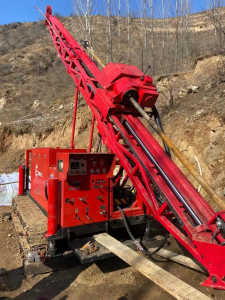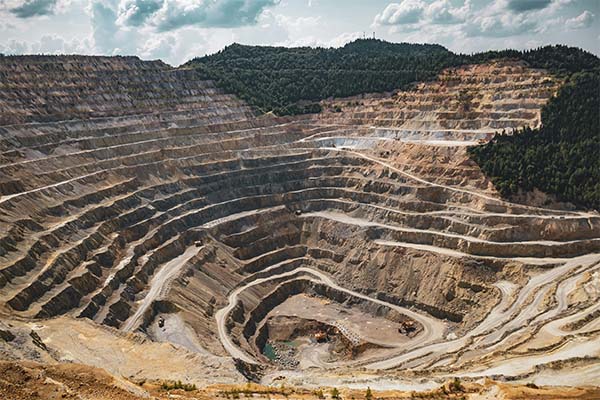
I. Basic Functional Requirements of Drilling Rigs in Drilling Processes
To meet the demands of core drilling, a drilling rig must fulfill the following essential functions:
Provide Rotational Power: Deliver the rotary force needed to drive the drill string and rock-breaking tools (drill bits) to fracture rock formations.
Apply and Adjust Pressure: Supply downward pressure to the drill bit for penetrating rock, with the ability to regulate this force as needed.
Handle Tool Retrieval: Possess the capability to raise and lower drilling tools efficiently.
II. Types of Drilling Rigs
Drilling rigs used in core drilling are categorized as follows:
Mechanical Drilling Rigs: Including spindle-type rigs and rotary table rigs.
Fully Hydraulic Drilling Rigs: Powered entirely by hydraulic systems.
Additionally, there are other types such as rotary piling rigs, truck-mounted rigs, and crawler-mounted rigs, which serve specialized purposes.
III. Key Parameters for Selecting and Evaluating Drilling Rigs
The technical specifications of drilling rigs are divided into three main categories:
Basic Parameters: These reflect the rig’s drilling capacity and stability, typically expressed as a combination of drilling depth and drill rod diameter.
Primary Parameters: Derived from basic parameters, these include:
Rotational speed of the rotator.
Upward thrust and drilling force.
Feed speed and stroke length.
Lifting capacity and speed.
Rig weight, overall dimensions, and power source specifications (e.g., engine power and speed).
General Parameters: Secondary specifications subordinate to basic and primary parameters, such as wire rope diameter and drum diameter, which indicate less critical technical details.
IV. Components of Mechanical Transmission Drilling Rigs
(1) Rotator and Chuck
Rotator: Transfers rotational power, providing drilling speed and torque, with the ability to rotate in both directions.
Chuck: Found in spindle-type rigs (not in rotary table rigs, where it’s integrated with the rotator), the chuck transmits rotational motion and torque while clamping the drill rod. It also facilitates axial movement and drilling (or upward) force.
(2) Feed Mechanism
The feed mechanism is a critical component in rotary drilling, responsible for:
Measuring drill bit weight.
Applying or reducing drilling pressure.
Providing consistent axial force and drilling speed.
Retracting, lifting, and suspending drilling tools.
Forcefully extracting stuck tools.
Feed mechanisms are available in two types:
Hydraulic Feed: Driven by hydraulic cylinders.
Manual Mechanical Feed: Operated manually with mechanical rotation.
(3) Hoist
Also known as a winch or drawworks, the hoist is used to:
Raise and lower drilling tools and casings during operation.
Assist in reduced-pressure drilling or handle in-hole incidents by working with the feed mechanism for forceful extraction.
(4) Gearbox and Transfer Case
Gearbox: Adjusts the speed and torque of the rotator and hoist.
Transfer Case: Distributes power to the rotator and hoist, enabling independent or simultaneous operation of both systems.
(5) Friction Clutch
The friction clutch serves to:
Engage or disengage power from the engine.
Facilitate gear shifting and specialized in-hole operations (e.g., coring or breaking off core samples).
Provide overload protection.
Simplified Diagram of Spindle-Type Rig Components:
Power source
Clutch
Gearbox
Transfer case
Spindle
Hoist
Water brake
Hydraulic pump
Carriage
Base
V. Fully Hydraulic Drilling Rigs
A fully hydraulic drilling rig uses hydraulic systems to drive its rotation, drilling, and tool-lifting mechanisms. It typically consists of three main parts: the main unit, pump station, and control console, connected by high-pressure hoses.
Simplified Structural Diagram of a Fully Hydraulic Rig:
Pump station
High-pressure hose
Main unit
Control console
Features of Fully Hydraulic Drilling Rigs:
Unique Design: Unlike traditional mechanical rigs, it comprises three distinct components with a simpler structure.
Stepless Speed Control: Offers infinite speed adjustments.
Towerless Lifting: Enables mechanical, automated tool connection and disconnection.
Ease of Operation: Requires fewer workers and simplifies tasks.
Remote Operation: Allows safer operation over distances, including potential remote control.
Long Stroke Advantage: Unlike spindle rigs, which require a detachable drilling frame and have a short stroke (under 1m), fully hydraulic core rigs can handle longer drill rods (e.g., 3m) in a single operation without frequent rod retraction.
Drawbacks:
High Power Consumption: Lower mechanical efficiency.
Precision Requirements: Hydraulic components demand high precision, and the system requires strict hydraulic oil quality and filtration, making maintenance challenging.


